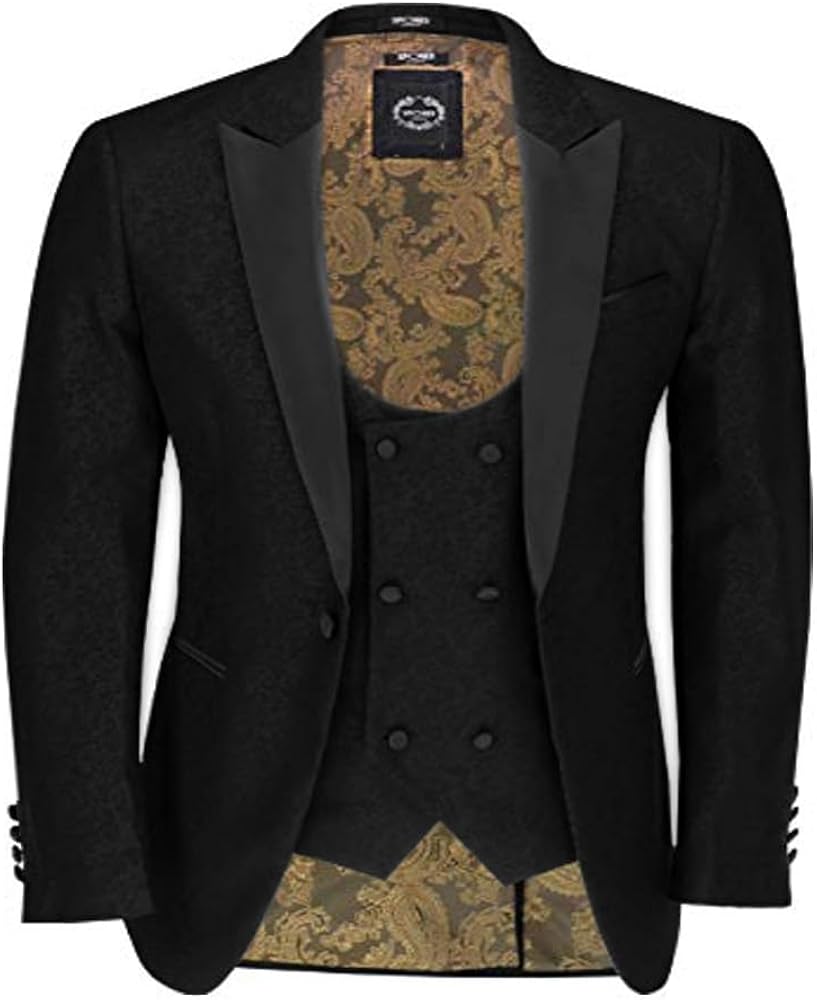Brands/Products
How to Wear a Tuxedo: A Simple Guide

A tuxedo is a classic symbol of elegance and sophistication in men’s formalwear. Whether you’re attending a wedding, gala, or any black-tie event, wearing a tuxedo makes you stand out with style and grace. But how exactly do you wear one, and what makes a tuxedo special? Let’s dive into everything you need to know about wearing a tuxedo with confidence.
What is a Tuxedo?
A tuxedo is a formal suit that typically includes a black or dark-colored jacket with satin lapels, matching trousers with satin side stripes, a formal white shirt, a bow tie, and often a waistcoat or cummerbund. It’s meant for formal evening events, and while it follows certain traditional rules, modern tuxedos come with plenty of options to suit different tastes.
The first step in wearing a tuxedo is choosing the right one for your occasion. You’ll want to make sure it fits perfectly, as a well-fitted tuxedo elevates your look instantly. Start by selecting a tuxedo that matches your body shape. Once you’ve got the fit down, pair it with a formal shirt and bow tie, and you’re good to go!
Now, let’s explore why tuxedos remain a top choice for formal occasions by looking at their advantages. These are readily available online at Xposed London tuxedos.
The Advantages of Wearing a Tuxedo
1. Comfort Options of a Tuxedo
One of the biggest misconceptions is that tuxedos are uncomfortable. However, modern tuxedos are designed to offer maximum comfort. Tailored tuxedos, in particular, allow for better movement and breathability, which is essential during long events. Fabrics like wool or wool blends are commonly used, providing both a comfortable fit and enough structure to maintain the formal look.
Many tuxedos now come with stretchable materials, so you don’t have to worry about feeling stiff or restricted. If you’re attending an event that runs for hours, comfort is key, and a good tuxedo will keep you feeling at ease without sacrificing style.
2. Long-Lasting Durability
Tuxedos are built to last. The quality of the fabric and the craftsmanship make them highly durable, allowing you to wear them multiple times without losing their appeal. A well-made tuxedo can last for years, making it a smart investment, especially if you attend several formal events.
Because tuxedos are designed for special occasions, they are less likely to wear out quickly compared to regular suits. By taking care of your tuxedo through proper cleaning and storage, you can maintain its crisp, stylish look for years.
3. Variety of Types of Tuxedos
Tuxedos come in various styles to suit different preferences and events. You can choose between single-breasted and double-breasted jackets, opt for notch, peak, or shawl lapels, and even play around with different colors like midnight blue or ivory. This variety ensures you can select the tuxedo that best suits your personality and the occasion.
For example, a classic black tuxedo with satin lapels is perfect for black-tie events, while a more relaxed, modern option like a velvet dinner jacket adds a touch of flair to your look. The variety available today allows you to express your style while adhering to the traditional formal dress code.
4. Moisture Resistance
Many high-quality tuxedos are made from materials that offer moisture resistance. This feature helps in maintaining the pristine appearance of your tuxedo, especially if you’re attending an event where you might be moving around a lot. Wool, for instance, naturally resists moisture, which can prevent sweat stains and keep the fabric looking fresh throughout the evening.
Moisture resistance is particularly beneficial in humid or warm climates, ensuring you stay comfortable and dry even during long formal gatherings. With this added benefit, tuxedos maintain their polished look and help you feel more confident.
5. Stylish Appearance
Let’s face it – a tuxedo is the ultimate symbol of style and sophistication. The sleek cut, satin lapels, and timeless appeal make anyone wearing one stand out. Tuxedos are designed to make you look your best by enhancing your posture and overall appearance. When you put on a tuxedo, you immediately convey a sense of class and elegance, which is why they remain a popular choice for formal events.
From the carefully tailored fit to the subtle details like cufflinks and pocket squares, wearing a tuxedo brings a touch of refinement that is hard to match with other formalwear options. It’s a style that has stood the test of time for good reason.
6. Smooth and Wrinkle-Free
Another great advantage of tuxedos is their smooth, wrinkle-free look. Quality tuxedos are made from fabrics that resist wrinkling, so even after sitting for long periods or moving around, your tuxedo will still look sharp. The smooth texture of a tuxedo, especially when paired with satin lapels, adds a luxurious finish to your overall appearance.
The wrinkle-resistant feature ensures that you look polished throughout the event, giving you one less thing to worry about. A well-maintained tuxedo allows you to present yourself with confidence, knowing that your outfit will remain in top condition all night long.
Conclusion
Wearing a tuxedo is more than just following a dress code – it’s about embracing a style that speaks of elegance and sophistication. From comfort and durability to moisture resistance and stylish appearance, tuxedos offer several advantages that make them the go-to choice for formal events. With a variety of styles available, you can find the perfect tuxedo that suits your personality and the occasion.
Brands/Products
Lafarge Africa Debuts Beyond Buildings Campaign

By Adedapo Adesanya
Top building materials and solutions brand, Lafarge Africa Plc, has unveiled a new thematic campaign tagged Beyond Buildings geared towards highlighting its impact and contributions to Nigeria’s infrastructural development.
The campaign was unveiled by the chief executive of Lafarge Africa, Mr Lolu Alade-Akinyemi, on Monday, December 8, 2025, in Lagos.
Mr Alade-Akinyemi noted that the campaign highlights how Lafarge, through innovative and sustainable building solutions, has continued to shape the socio-economic development and progress of Nigerians and Nigeria by contributing to the construction of various structures, including iconic buildings and bridges, stadiums, hospitals, roads, and more, ultimately aiding the nation’s overall growth.
“For over six decades, beyond the manufacturing of building solutions, we have partnered in building the very foundation of Nigeria’s infrastructural development and its future. With our innovative solutions, we have made a significant contribution to our nation’s progress by providing essential building materials for numerous landmark projects.
“This also extends to the expansion of our production capacity nationwide, creating jobs and livelihoods, bringing development to communities, and introducing innovative products to meet the ever-evolving construction needs of Nigeria,” he said.
He described the campaign as a celebration of strength, innovation, history, shared success, and the power of progress, noting that it is the story of the company’s humble beginnings, which dates back to 1960 when its first factory began production.
“The Beyond Buildings campaign is the story of our vision, which is to be the leading building solutions company, driving innovation and operational excellence to create a greener planet and enable national progress. It shifts the narrative from our products to the profound impact we make on human lives. Our materials transform into national landmarks, powering jobs, livelihoods, and development across every state,” he noted.
The thematic campaign Beyond Buildings spotlights how Lafarge has been a strong and steady partner in building infrastructure that underpins Nigeria’s socio-economic progress.
“We are celebrating our enduring legacy and committing to a new era of sustainable and innovative growth. This campaign empowers us to tell that story with confidence and clarity,” he added.
Delivering his remarks, the Commercial Director of Lafarge Africa, Mr Gbenga Onimowo, stressed that the premiere viewing is an opportunity to share the compelling reasons why the company’s story, ‘Beyond Buildings,’ must be told.
Mr Onimowo stated that the campaign aims to reinforce the company’s position at the heart of Nigeria’s construction growth since independence, as demonstrated by its extensive footprint of infrastructure development across every corner of the country.
‘However, our contribution is not merely about building solutions including cement, mortar, plaster of paris and readymix concrete. It’s about the shared future and the national development we actively enable,’ he said.
He stated that the campaign was designed to move the conversation past the physical structures and shine a light on the socio-economic impact that the company helps create.
“Our campaign highlights the immense progress built on the concrete of trust since 1960. Our materials are integral to iconic landmarks like the National Theatre, 1st and 2nd Niger Bridges, Third Mainland bridge, Lekki-Ikoyi link bridge, the National Assembly Complex and countless national, commercial, academic and residential structures nationwide,” he added.
The event was well attended by distinguished stakeholders from the building and construction sector as well as the arts, culture, media and entertainment industry, alongside many of the company’s esteemed customers including veteran Nollywood actors Richard Mofe-Damijo (RMD) and Kate Henshaw.
Brands/Products
X3M Ideas Emerges Agency of the Year at LAIF 20th Anniversary

By Modupe Gbadeyanka
The prestigious Agency of the Year title has been clinched by X3M Ideas, a foremost integrated marketing communications (IMC) firm in Africa, at the Lagos Advertising and Ideas Festival (LAIF) Awards.
LAIF rolled out drums to celebrate its 20th anniversary at the Marriott Hotel, GRA Ikeja, Lagos, on Sunday, November 30, 2025.
The award ceremony, themed 20 Years of Crazy, was attended by several stakeholders in the IMC sector in the country.
At the event, X3M Ideas, established by a veteran in the industry, Mr Steve Babaeko, topped the medal table with 12 Gold, 20 Silver, and 24 Bronze awards, totalling 336 points. The second and third-placed agencies scored 153 and 141 points, respectively.
In 2023, X3M Ideas achieved a similar feat at LAIF and also emerged African Agency of the Year at the 2023 and 2024 editions of the African Cristal Awards.
During this period, Mr Babaeko was named African Personality of the Year, reaffirming the agency’s position as a leader in the African advertising industry.
The 2025 edition of LAIF was also a double celebration for X3M Ideas, as Mr Babaeko, alongside other industry leaders, received special recognitions and commemorative plaques for their invaluable contributions to establishing LAIF as West Africa’s premier creative showcase.
“We are extremely excited to win again at LAIF. This achievement demonstrates how we have continuously evolved, innovated, and remained creative, going ‘crazy’, in line with the theme of the award, by turning every brief into campaigns that resonate across all ages.
“This win also signifies that, together whether as individuals, agencies, or brands, we can shape the future of advertising, push boundaries, and redefine excellence,” Mr Babaeko, who is the Chief Creative Officer of X3M Ideas, said.
Recall, X3M Ideas broke a 70-year jinx to become the first Nigerian and West African agency to win at the Cannes Lions International Festival of Creativity.
The agency continues to put Nigeria on the global map, winning notable awards at the 2024 Lisbon International Advertising Festivals Group.
Additionally, X3M Ideas was recognised as one of Africa’s fastest-growing companies for 2025 by the Financial Times, ranked 31st among 130 companies across the continent.
Its campaign, Blood Sacrifice, also won at the 2025 Cannes Lions Festival, earning top honours at the prestigious ACT Responsible exhibition.
LAIF was established through the bold vision of the Association of Advertising Agencies of Nigeria (AAAN) to celebrate and elevate creativity within Nigeria’s marketing communications industry.
Brands/Products
Netflix to Buy Warner Bros. Discovery in $82.7bn Mega Deal

By Adedapo Adesanya
Netflix has reached a deal with Warner Bros. Discovery to buy the legendary TV and movie studio and assets like the HBO Max streaming service for $82.7 billion.
Warner Bros. Discovery is moving forward with its plans to split into two publicly traded halves in 2026. Once the split takes effect, Netflix intends to acquire the Warner Bros. half. The other half, Discovery Global, will house CNN and other cable channels. The Warner Bros. half includes its film and television studios, HBO Max and HBO.
The transaction values Warner Bros. Discovery at $27.75 per share, implying a total equity value of approximately $72.0 billion and an enterprise value of approximately $82.7 billion.
The deal is subject to regulatory conditions, of which there will be several, due to the size of the companies involved and what it means for competitiveness.
For several weeks, Paramount was thought to be the frontrunner in the auction for Warner Bros. Discovery. Paramount executives, who want to buy all of Warner Bros. Discovery – including its cable assets – were confident about their merger proposal and their mutually beneficial relationship with President Donald Trump.
However, Netflix surprised many with the boldness of its bids as it agreed to the same costly breakup fee that Paramount proposed, according to reports. This means the would-be buyer will pay Warner Bros. Discovery billions of dollars if the deal is not completed.
“Our mission has always been to entertain the world,” said Mr Ted Sarandos, co-CEO of Netflix. “By combining Warner Bros.’ incredible library of shows and movies—from timeless classics like Casablanca and Citizen Kane to modern favorites like Harry Potter and Friends—with our culture-defining titles like Stranger Things, KPop Demon Hunters and Squid Game, we’ll be able to do that even better. Together, we can give audiences more of what they love and help define the next century of storytelling.”
Mr Greg Peters, the other co-CEO of Netflix, said the acquisition would “improve our offering and accelerate our business for decades to come,” adding: “Warner Bros. has helped define entertainment for more than a century and continues to do so with phenomenal creative executives and production capabilities. With our global reach and proven business model, we can introduce a broader audience to the worlds they create—giving our members more options, attracting more fans to our best-in-class streaming service, strengthening the entire entertainment industry and creating more value for shareholders.”
“Today’s announcement combines two of the greatest storytelling companies in the world to bring to even more people the entertainment they love to watch the most,” said David Zaslav, President and CEO of Warner Bros. Discovery. “For more than a century, Warner Bros. has thrilled audiences, captured the world’s attention, and shaped our culture. By coming together with Netflix, we will ensure people everywhere will continue to enjoy the world’s most resonant stories for generations to come.”
The terms of the agreement will see each Warner Bros. Discovery shareholder receive $23.25 in cash and $4.50 in shares of Netflix common stock for Warner Bros. Discovery common stock share.
-

 Feature/OPED6 years ago
Feature/OPED6 years agoDavos was Different this year
-
Travel/Tourism9 years ago
Lagos Seals Western Lodge Hotel In Ikorodu
-

 Showbiz3 years ago
Showbiz3 years agoEstranged Lover Releases Videos of Empress Njamah Bathing
-

 Banking7 years ago
Banking7 years agoSort Codes of GTBank Branches in Nigeria
-

 Economy3 years ago
Economy3 years agoSubsidy Removal: CNG at N130 Per Litre Cheaper Than Petrol—IPMAN
-

 Banking3 years ago
Banking3 years agoFirst Bank Announces Planned Downtime
-

 Banking3 years ago
Banking3 years agoSort Codes of UBA Branches in Nigeria
-

 Sports3 years ago
Sports3 years agoHighest Paid Nigerian Footballer – How Much Do Nigerian Footballers Earn












